At the easternmost edge of Lake Erie, where the lake meets the Niagara River, the Peace Bridge connects the United States and Canada. The two-thirds-of-a-mile-long bridge is one of the busiest border crossings between the two countries, connecting Canada’s Fort Erie with Buffalo, New York. Every day, an average of more than 15,000 vehicles, about 3,400 of which are trucks, drive over its steel girders.
In the shadow of the bridge sits a small neighborhood called the West Side, where the asthma rate is more than four times the national average, and residents report a host of other health issues. Advocates say the thousands of trucks driving overhead spew harmful diesel emissions and other particulates into their community. The pollutants hover in the air, are absorbed into buildings and houses, and find their way into the lungs of neighborhood residents, who are primarily people of color. “It’s constant asthma problems on the West Side,” says Sharon Tell, a local resident.
Idling trucks, with their engines running, are a regular presence on residential streets. “You see them park on our streets now, and sleeping overnight,” she says. “It’s so much, and we’re right there.” Tell is one of several residents who wore an air monitor funded through an Environmental Protection Agency grant. Her device collected more than 1.8 times the EPA recommended limit of particle pollutants. Tell could only wear the monitor for eight hours during a single day—the cost of conducting the air quality test is prohibitively expensive—but the result was deeply alarming. According to the EPA’s standards, the recommended limit on particle pollutants should not be “exceeded more than once per year on average over 3 years” (emphasis added).
Far from addressing the community’s concerns, plans are now afoot to expand the Peace Bridge. A proposed expansion of the bridge’s on- and off-ramps will further encroach into the neighborhood’s streets. Residents say their concerns about the constant truck traffic and its deleterious health consequences are being consistently ignored. “We have to move past the point where your zip code determines the quality of your life,” says Virginia Golden, a Buffalo resident and activist.
* * *
Race and transportation have long been intertwined, whether it be federally funded highways that plowed through, or isolated, minority neighborhoods; Rosa Parks and the Montgomery Bus Boycott; or segregated streetcars and trolleys. And there has been tremendous progress within the past century, particularly when Brown v. Board of Education struck down “separate but equal,” leading to the eventual desegregation of public transportation. In the 1990s, two pieces of legislation, the Intermodal Surface Transportation Efficiency Act and the Transportation Equity Act for the 21st Century, increased community involvement and awareness of civil rights issues in transportation planning. But discrimination, while certainly less overt, remains today.

Photo by Glenn Asakawa/Denver Post Staff
Sometimes, as in Buffalo’s case, communities feel cut out of the decision-making process. Those in power make decisions about transportation planning, resulting in ill-planned bus routes, transportation more likely to benefit those with cars than those without, and bleak environmental costs. In some cities, roads continue to pull apart neighborhoods, prioritizing commuters over communities. Nationally, the United States remains a country where many forms of transportation are effectively still segregated—whites and minorities ride different kinds of transportation, resulting in an unequal ability to reach jobs, education, and a better life. “Discrimination in transportation, quite often it’s more subtle today,” says Robert Bullard, dean of Texas Southern University’s school of public affairs, and a co-editor of Highway Robbery: Transportation Racism and New Routes to Equity. “We don’t have laws about posting signs for whites and coloreds. We don’t have laws segregating people on buses and trains … [but] if you look at quality of service, efficiency of service, look at amenities attached to suburban rail versus inner-city bus lines, it’s like night and day.”
In Buffalo, the advocacy group Clean Air Coalition of Western New York filed a Title VI complaint against expansion of the Peace Bridge in response to what the organization’s members call an exclusionary process. This type of administrative complaint uses the Civil Rights Act of 1964 as grounds for identifying and fighting discrimination. The landmark law forbids the recipients of federal funding from discriminating based on race, color, or national origin. Although occasionally used in lawsuits, which generally require proving discriminatory intent, Title VI complaints require demonstrating only that a federally funded transportation project has a discriminatory (or, in technical terms, “disparate”) impact. If a transportation project can be proven to have a disparate impact, agencies can cut a project’s federal funding. In 2010, of the $40.2 billion in public funds allotted for transit, $10.4 billion were federal funds.
Based on recent complaints provided by the Federal Highway Administration and Federal Transit Authority through Freedom of Information Act requests, as well as older complaints and several lawsuits, I closely examined about 40 cases of racial discrimination in transportation planning, many from the past 15 years. I interviewed people and lawyers involved, and looked at the relationship between transportation funding and race around the country. (These cases included Juneau, Memphis, Boston, Houston, Johnson County, Kansas, and the Gila River Indian Community, a reservation in Arizona.) While the presence of a Title VI complaint or lawsuit isn’t sufficient on its own to prove discrimination—and conversely, the lack of a complaint cannot be assumed to indicate a fair and equitable transportation system—these complaints underscore that transit is often not available to those who need it most, and that new public transportation projects often serve those who own cars, at the expense of those who don’t.
It’s a problem in most corners of the United States. In New Orleans, Hurricane Katrina brought public transportation to a standstill. Just a year later, the city’s historic streetcars began to return, taking commuters and tourists to downtown destinations. But longtime New Orleans residents say that some buses serving low-income and minority neighborhoods haven’t been seen since before the storm, and others have wait times so long that the buses are practically useless. “We see transportation coming back, but not to our community,” says Katherine Prevost, a community activist and lifetime New Orleans resident. Prevost, 61, is president of the Bunny Friend Neighborhood Association, which has organized and collected signatures for the return of its neighborhood bus line. Her neighborhood, St. Claude, has only 32 percent of the weekly bus trips that it did before Katrina. It is 81 percent black, with an average household income of $29,029. Thirty percent of households have no vehicle, and about 51 percent have just one.
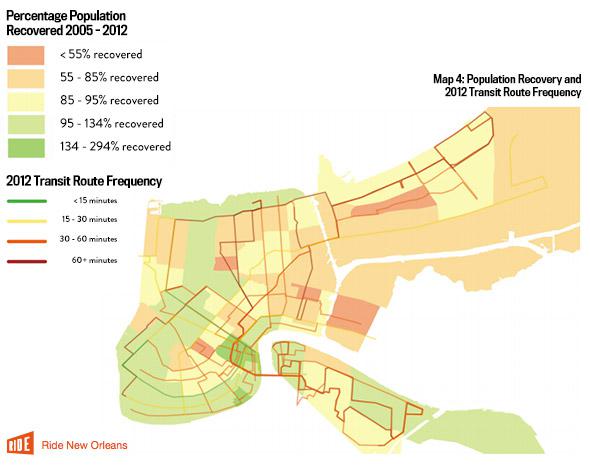
Ride New Orleans
According to a 2014 report by the nonprofit Ride New Orleans, 86 percent of New Orleans’ population has returned to the city, but only 36 percent of its transit service, measured by number of trips, had been restored.* Perhaps unsurprisingly, people of color, low-income neighborhoods, and those without cars have taken the brunt of the burden. By that same year, a full seven years after the storm, the New Orleans Regional Transit Authority had restored 77 percent of trips to the streetcar lines, but only 29 percent of its bus routes. The gap between buses is more than an hour on 18 percent of these lines. Transit is built “where they figure they can make money—places like Canal Street and St. Charles,” said Prevost. “The poor people that really need the transportation don’t have it.”
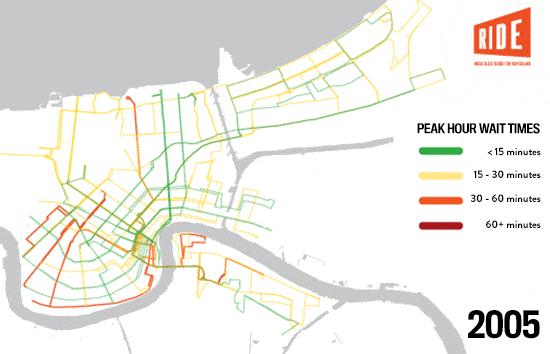
Ride New Orleans
In Oakland, California, a $484 million elevated “people mover” (which connects Bay Area Rapid Transit to the airport) lost federal funding because it was found to have a discriminatory impact; its construction led to the elimination of a bus route in the minority neighborhoods it bypasses. In Detroit, a streetcar line estimated to cost $137 million is being built downtown in a corridor that caters to business and office workers, but the project does nothing for the carless poor who live in the urban outskirts. “It is only moving people who are already there,” says Rev. Joan C. Ross, who is director of the group, North End Woodward Community Coalition, which filed a Title VI complaint. “In our community,” she estimates, “30 to 40 percent of people don’t have cars.”
In Johnson County, Kansas, bus service was cut in a way that the complainants said eliminated routes in black areas while leaving ones in white areas untouched. In Nashville, a Bus Rapid Transit project, creating dedicated lanes for buses, was expected to cost $175 million, and receive federal funding. After the community’s uproar, the controversial project was canceled late last month. But had it gone forward it would have served mainly white and middle- and upper-class neighborhoods, ignoring communities like North Nashville, where in some zip codes as many as 86 percent of residents are black and 28 percent don’t own cars.* In some cases, federal money goes to building roads, while ignoring the types of transportation used by low income and minority residents. In Milwaukee, for example, a $1.7 billion project called the Zoo Interchange initially used federal money for a highway project without funding public transit.* Last year, a lawsuit charging discrimination was settled; the settlement allocated $13.5 million of the project’s funding toward bus routes and improvements to the county transit system. “This is the most racially segregated region in the United States,” for black Americans, “and has been for decades,” says ACLU lawyer Karyn Rotker, of Milwaukee. “There have been billions spent for massive highway reconstruction, and repeated and ongoing efforts to interfere with transit.”
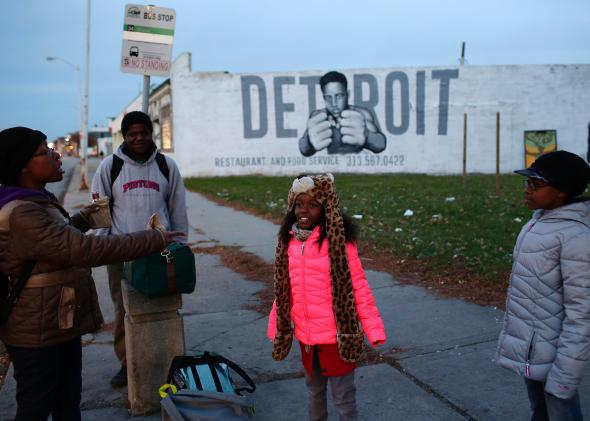
Photo by Joshua Lott/Getty Images
Cities may be designed for people without automobiles, but the suburbs have increasingly become the home of those without cars. The number of suburban poor increased by more than 60 percent between 2000 and 2012 according to the Brookings Institution, and public transportation systems have yet to catch up. For those without cars—according to 2013 U.S. Census data, 15.9 percent of blacks and 9.1 percent of Hispanics live in households without cars, compared to just 5 percent of whites—public transportation is not a convenience, but a necessity. “One of the stories we tell ourselves in the narrative of the United States is about social and physical mobility,” says Marc Brenman, co-author of the book The Right to Transportation: Moving to Equity. “You can’t have either of those kinds of mobility without an equitable transportation system.”
* * *
When buses started running to a suburban mall near Dayton, Ohio, in January 2014, online commenters, writing in the Dayton Daily News, erupted in anger. They resented—sometimes in purely racist terms—that this new public transportation line would be bringing outsiders, largely blacks, to Beavercreek, a suburb that is about 89 percent white.
“Homeless and thugs taking up residence in the food courts, thugs with no money wandering the hallways all day scaring off the people with money,” wrote Godsey97, commenting on a local newspaper story. “Let the shoplifting and Knockout Games begin,” said a commenter named Guesswho. Another commenter, brack, chimed in, “they have ruined schools, neighborhoods, companies, salem mall and Dayton mall and now the Beavercreek mall!!! time to flush political correctness and affirmative action.”
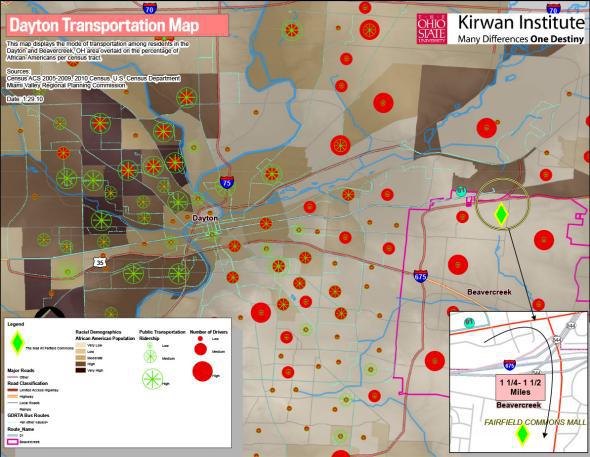
Kirwan Institute
The new bus service grew out of a conflict that had racked the area for decades, pitting the mostly white suburb against a church coalition and the local NAACP. The church coalition had been advocating for the buses for years, citing the dangerous commute from the nearest bus stop for riders, 73 percent of whom are minorities. Mall workers without cars had been forced to walk along a six-lane highway and then cross an overpass, hugging the fence at the overpass’s edge to avoid getting hit by an incoming vehicle. Finally, they would sprint across a large intersection with four to six lanes of traffic and no crosswalk. “Does someone have to die, being desperate to go to a job?” asked Deacon Ronnie Moreland, the then-president of the church-based group, Leadership for Equality and Action in Dayton, in an interview in early 2013.
The new bus service in Beavercreek, although limited, was the result of a Title VI complaint, filed by Moreland’s church group. For more than a decade, the citizens of Beavercreek had fought the buses, claiming that they’d bring crime into their community. In an attempt to squash the public transportation effort, the city council requested restrictive bus-stop regulations, including requiring substantial shelters, lights, police call boxes, and surveillance cameras. In June 2013, about a year after a federal investigator came to Dayton, the Federal Highway Administration released the results of its investigation: Beavercreek’s rejection of bus stops was, in fact, discriminatory. “African Americans have faced discriminatory impact as a result of the City’s decision to deny the [Regional Transit Authority’s] application to install bus stops,” the federal report read.
Beavercreek isn’t unique. “The fact that there wasn’t service [in Beavercreek], and was resistance to service there demonstrates a trend we’ve seen in other parts of the country, of seeing transit as delivering undesirables to the area,” says Jason Reece, director of research at the Kirwan Institute for the Study of Race and Ethnicity at Ohio State University. “It’s not uncommon to get pushback to bus stops, and even bike paths and trails.”
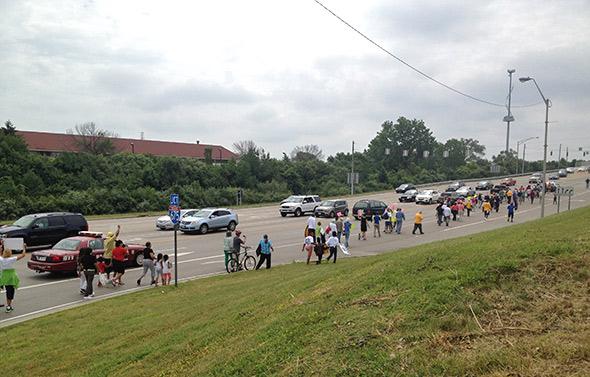
Photo courtesy Cory Ramey
In August 2013, people on both sides of the issue attended a city council meeting at Beavercreek’s city hall, a nondescript building in an industrial park, to debate whether they should reject the new bus stops, and therefore lose the federal funding that came with them. At the end of the meeting agenda, attendees each had three minutes to address the room.
Among those who opposed the new bus routes, upset citizens bemoaned the criminals or unruly teenagers the buses would bring to the mall. They felt Beavercreek had been the subject of a smear campaign, and they were fed up with being called racist: by the blogosphere, the local paper, and, in some cases, their friends and neighbors.
For some in the crowded room, it was an issue of individual responsibility; they had pulled themselves up by their bootstraps—without a public bus, mind you—and said that others should as well. A woman named Cathy Bryan said she had paid her way through college by waiting tables and tending bar. “I figured it out, and if you care, you’ll figure it out, too,” she said.
Some at the meeting feared a future regional, cross-county transportation system that would ostensibly connect what they viewed as isolated, safe suburbs with urban or poverty-ridden areas. The issue of crime came up repeatedly. Invoking the question of civil rights, Ronald Brandon of Beavercreek asked, “What about ours?”
Others resented being bossed around by the federal government. Bill Curtice said that it was worth losing the federal dollars in order for Beavercreek to maintain its autonomy. “I encourage you to take fresh courage,” he said to the council. “Our highway funds are being held hostage,” said another woman.
On the other side of the issue, person after person got up and told the city council why they needed a bus, their words spilling out until they were cut off at the three-minute mark. A white woman from Beavercreek said her church, which was located near the mall, had trouble hiring child care workers because the applicants were dependent on public transportation. “I cannot stand here and say there is no racial element,” she said. “I’m confident that there is, knowing that the racial issues are much more under the surface than they used to be.” A black woman, Deborah Wagner, said a bus would help her family get to doctor’s appointments, so that Wagner herself wouldn’t have to miss work to drive. She took issue with the emphasis on teenagers and parenting. “That’s an insult to a black mother,” she said.
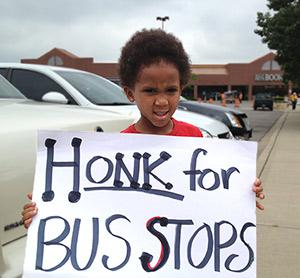
Photo courtesy Cory Ramey
At the end, the mayor, looking exhausted and exasperated, closed the meeting and made a beeline for the door. But in an interview a few weeks later at a Panera in another mall in town, Beavercreek’s mayor at the time, Vicki Giambrone, argued that the federal decision, which found that banning the buses resulted in discrimination, was motivated by economics, not race. “This was about three bus stops on one stretch of road, and not about race or certain kinds of people or public transit in general,” said Giambrone. “The Federal Highway report says we ran a racially neutral process, and that often gets left out of any stories.” (That is true, says Ellis Jacobs, an attorney with Advocates for Basic Legal Equality, which worked with the church group. The decision doesn’t accuse the Beavercreek council of having discriminatory intent, but does make clear the process had a discriminatory impact.)
Since January 2014, buses have been running to the mall, although on a limited basis; on a weekday, buses come every hour or so. In May, the Dayton Daily News’ analysis of crime statistics from the first two months of bus service found that crime hadn’t increased.
* * *
Citizen groups first began to use Title VI to fight racial disparities in major transportation systems in the mid-1990s. One of the earliest was Los Angeles’ Bus Riders Union. At the time, L.A.’s fleet of buses was old, overcrowded, and prone to breaking down. Rather than refurbishing or replacing its bus fleet, the city planned to decrease bus service and get rid of monthly bus passes, while building a billion-dollar rail line. (As in many cities, bus ridership was largely lower-income minorities, and rail ridership tended toward wealthier whites.) In 1996, the Bus Riders Union lawsuit was settled, resulting in a 10-year consent decree, which placed stringent rules on transit funding. The decree forced the transit authority to retain the monthly bus pass at a lower cost, purchase more than 100 new buses, and create new routes specifically to help people of color. “[The finding] caused a lot of people in the transportation world to sit up and say, ‘What’s going on?’ ” says Joe Grengs, an urban planning professor at the University of Michigan.
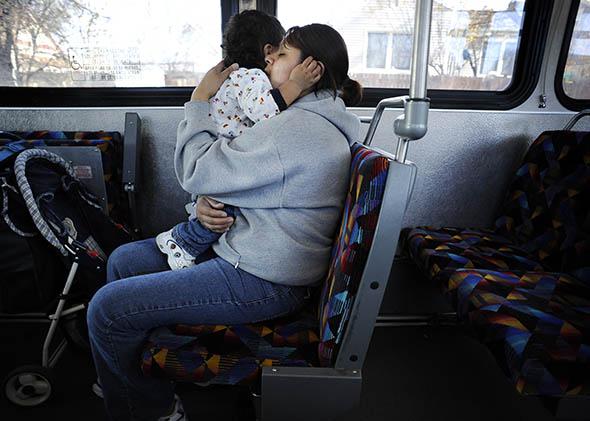
Photo by Craig F. Walker/The Denver Post
“That case really crystalized the link between civil rights and transportation more than any other case in recent history,” says Guillermo Mayer, president and chief executive of Public Advocates, who has worked on more recent Title VI lawsuits and administrative complaints, including with the Bus Riders Union.
Then, in 2001, the Supreme Court dramatically changed the way advocates could use Title VI. In the case Alexander v. Sandoval, the court altered the standard, concluding that an individual had to prove that the policy was intended to cause discrimination, a much higher bar to prove. Advocacy groups, like the Bus Riders Union, who fight for greater funding being allocated to transportation systems for minority communities, could no longer realistically take their claims to the courts. “Without that right of private action, you have to go to the agencies themselves,” says Bob Allen, director of policy and advocacy campaigns at Urban Habitat, a Bay Area advocacy group that has been involved with filing Title VI complaints. Filing administrative complaints are entirely dependent on the enforcement of individual people at individual government agencies, says Allen.
The Federal Highway Administration receives 40 to 60 complaints each year and investigates about seven, says spokesman Doug Hecox. The FTA received seven Title VI complaints in fiscal year 2014, according to a spokeswoman.
Janet Rogers, co-founder of the advocacy group Transit Action Network, which filed a Title VI complaint in Kansas in 2012, remembers calling her contact at the FTA. “He said there were so many Title VI complaints from this region that he wanted to know if there was something in the water,” she said. Complaints tend to fall into general categories: funding transit used by wealthier whites, like light rails and trolleys, over buses, whose ridership tends to consist of people with lower incomes and minorities; funding roads without devoting money to types of transit used by those without cars; and transit that helps wealthier populations while having negative health or environmental effects on poor communities.
Some of these Title VI complaints get resolved after federal investigators visit, but others languish in bureaucratic limbo for years, especially those filed without legal representation. “When you have lawyers behind you they treat you differently,” says JoNina Ervin, who was involved in filing Title VI complaints in Memphis and Nashville, both without legal help. “With just citizens, they are dismissive.”
But after the Supreme Court’s ruling, citizen groups lost their best weapon for fighting back. Even the Federal Highway Administration, in a civil rights self-assessment it conducted in 2009, concluded that it lacks the funding, organization, and expertise to level the playing field. “Alexander v. Sandoval had quite sweeping ramifications,” says Grengs, the urban planning professor. “It really threw a wet blanket on the potential for pushing government agencies on civil rights issues … and it really elevated the bar that you had to clear for proving intentional discrimination.”
* * *
Erin Heaney and Natasha Soto are driving around Buffalo’s West Side, pointing out neighborhood landmarks. They both work for the Clean Air Coalition of Western New York, which has advocated against the Peace Bridge expansion. One of the first sites is Public School 3, where nearly one-quarter of the students have asthma. In Front Park, a largely undeveloped green space adjacent to a ramp for highway I-90, Heaney, the nonprofit’s director, recalls holding a field day with local kids. “We were there from 7 a.m. to 3 p.m., and afterward I felt like I’d smoked a pack of cigarettes,” she says.
The bridge, and the truck traffic surrounding it, is not a new concern. For as long as local people can remember, elected officials have been trying to expand the bridge. At one point, the whole bridge was to be revamped, at a cost of $350 million, but the project didn’t pass an environmental review. The current project, contracted for $56.2 million so far, has begun and is expected to be complete in 2017.
Neighborhood residents say that widening the plaza and bringing even more trucks into a residential neighborhood will have serious health consequences, which will disproportionately harm the minority community. The neighborhood is 25 percent black, 39 percent Hispanic, and 43 percent white, with 48 percent of residents living below the poverty line.
More alarming, residents believe that public officials have figured out a way to have the bridge expansion go forward without running afoul of another environmental review. Based on recent purchases of area real estate by the Buffalo and Fort Erie Public Bridge Authority, which manages the bridge, residents fear that the Bridge Authority is dividing the work into smaller projects so that, in its discrete individual parts, the project can pass environmental muster. “They continue to take the approach of segmenting the environmental impact into individual projects that they say are completely independent, when no one in their right mind would see that as anything other than legal semantics,” says Joseph Gardella Jr., a chemistry professor at the State University of New York at Buffalo who studies air pollution.
In preparation for the expansion—and as a result of that initial complaint, says the Clean Air Coalition—the Department of Transportation held several community meetings, which Soto said were publicized poorly, with little advance notice and in publications community members do not read.
Community activist Providencia Carrión, who has lived on Buffalo’s West Side since the 1970s and raised her three children in the area, says she was one of five community members who attended one of the meetings. She recalls a conversation with an engineer. “There’s three bridges coming from Canada, through Buffalo,” she told him, suggesting that trucks could be routed through another border crossing. He replied that no, the trucks wanted to come over the Peace Bridge.
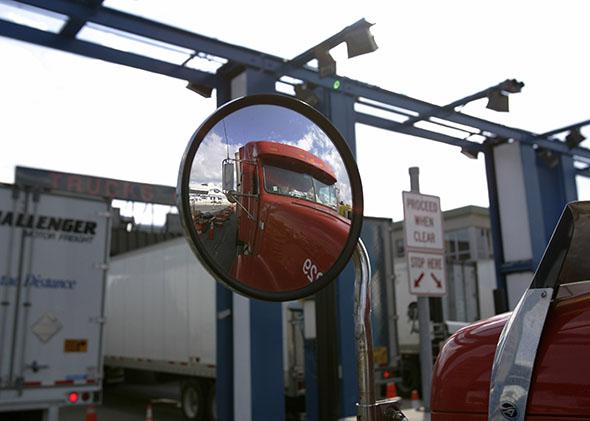
Photo by Robert Nickelsberg/Getty Images
“But I said, ‘The more trucks you pass through here, the more asthma you’re assigning us, and we don’t have no barriers.’ And he said, ‘People don’t die of asthma,’ ” she recalled
At the public meetings, the conversations haven’t been any more productive. At an April 2014 meeting of the Peace Bridge Authority board, Maria Lehman, a New York State Department of Transportation project manager, said that the Bridge Authority shouldn’t publicize the project until the day after the review is signed, meaning that the window for bringing a suit against it would be closed.
“So, but, can’t we promote this? Can’t we publicize this? Can’t we market this?” asked Anthony Masiello, a Bridge Authority board member who was present at the meeting, and is the former mayor of Buffalo. But Lehman explained why not: “I think some of it has been a conscious decision not to kick sleeping dogs that might not be paying as close of attention as they are.”
“We’ve had inclinations for a long time that that’s how they viewed us, that they didn’t really respect the neighborhood and just wanted to check boxes on their forms,” says Soto. Indeed, in the same board meeting, Lehman said, “We did this Burmese seven-language thing so we could check the box,” referring to the Bridge Authority’s effort to translate materials about the bridge expansion to languages spoken by people in the community, which includes Arabic, Nepali, Burmese, and others.
Soto said neither she nor her fellow activists were present at the meeting; she says the Bridge Authority’s board meetings have been held on an irregular basis in Canada, making it difficult for activists to attend. The only board meeting currently listed on the Peace Bridge’s website took place two months ago in Fort Erie, Ontario.
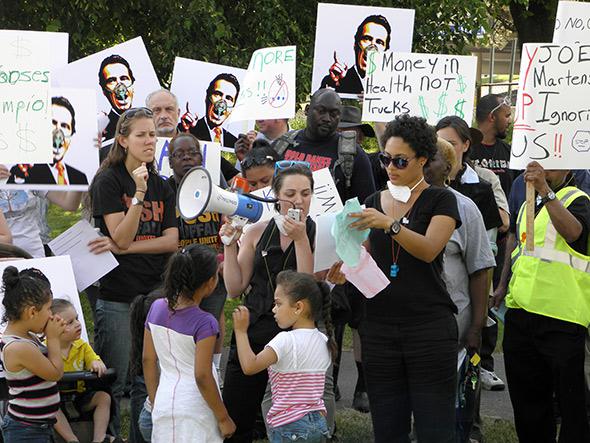
Photo courtesy Jonathan M. Roth
(A Peace Bridge Authority spokesman didn’t respond to a request for comment on the meetings. Likewise, an email to Lehman asking about the Peace Bridge expansion was answered by a spokeswoman for Gov. Andrew Cuomo, who said any questions about the project should be directed to the Federal Highway Administration.)
Lehman may have spoken freely at last April’s meeting because she believed none of the opponents to the bridge’s expansion were in attendance. Activists only became aware of her statements when a recording of the meeting was obtained through a Freedom of Information Request filed by Public Employees for Environmental Responsibility, an advocacy group that encourages public employees to work as “anonymous activists.”
Last year, the advocacy group submitted a complaint to the U.S. General Services Administration over the Peace Bridge expansion’s environmental review. “In essence the environmental review they did was premised on fictions—statements that there wouldn’t be increased traffic or that there was no controversy or no health risk to the community,” says Jeff Ruch, the group’s executive director. “They maintained the absurd position that the review wasn’t disseminated, and therefore it wasn’t required to be accurate.”
Like Carrión, many residents would like to see the trucks out of their neighborhood, and off the bridge altogether, a solution that seems unlikely politically or financially. Nearly half of the Bridge Authority’s yearly $33 million in revenue comes from commercial vehicle tolls and about $6.7 million comes from passenger vehicle tolls. Because there is no revenue sharing between the Peace Bridge and other local border crossings, it is in the Bridge Authority’s interest to draw as many trucks as possible. The alternative proposed border crossing for commercial trucks, the Lewiston-Queenston Bridge, while less populated, is demographically different: Residents are 96 percent white, with an average income of more than $58,000.
There are other possibilities that would at least mitigate the fumes and pollution. Today, there are no trees or other environmental barriers between the bridge ramp and duty-free plaza and the neighborhood. The Clean Air Coalition has proposed planting bamboo, which grows quickly and absorbs more carbon dioxide than trees or installing truck stop electrification stations, which would curb emissions from idling trucks. Neighborhood residents have suggested fixes like speed bumps or signs prohibiting trucks from neighborhood streets, where they currently park when drivers want to sleep or wait out heavy traffic.
Residents say they have won some small battles—the Bridge Authority hired a firm to create buffers—but, on a larger scale, residents still feel powerless, as the construction moves forward and the Bridge Authority plans to demolish another major property in the neighborhood, the former Episcopal Church Home, for unknown purposes. “They did have meetings for us, to get accountability of people who came to the meeting,” says Carrión, the activist. “I wish I would have known what I know now, because I wouldn’t have signed their sheet.”
Carrión had gone to the sessions, believing that they were an honest effort to solicit opinions from the neighborhood. “We went to all these meetings, and we were still thinking we were still in that process,” she says, adding that she, like several of her relatives, has asthma. “We thought they were going to change their mind. And give us the benefit of the doubt, or compromise. But they had their mind made up.”
Every time she passes a sign near the highway, it’s a reminder of what’s to come. “Right there, it says, the Peace Bridge plaza is coming,’ ” says Carrión. “All this fighting that we did, all that picketing that we do—these people didn’t hear us.”
*Correction, Feb. 27, 2015: This article originally misstated that Nashville’s Bus Rapid Transit project would cost $175 million and receive federal funding. The project was canceled in January.
*Correction, March 3, 2015: This article originally misstated that a report by the nonprofit Ride New Orleans was conducted in 2012. It was conducted in 2014. It also misstated that a Milwaukee project called the Zoo Interchange cost $850 million. It cost $1.7 billion.
This article was reported in partnership with The Investigative Fund at The Nation Institute, with support from The Puffin Foundation.
